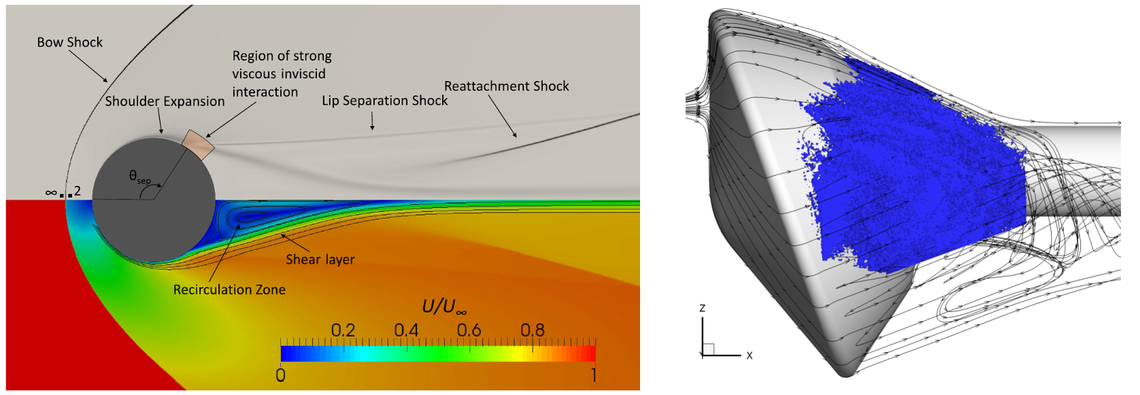Research
High-Speed Aerodynamics
Fundamental and applied research to the hypersonic atmospheric entry aerodynamics has been performed in the AERO-CORE group. Numerical simulations using the OpenFOAM were used to study the near wake of hypersonic blunt bodies, with an emphasis on the separation region, which is a result of a shock-wave-boundary-layer interaction (SWBLI). Collaboration with scientists at the NASA Langley Research Center allowed for planar laser-induced fluorescence (PLIF) imaging of the Mars Science Laboratory vehicle in the 31-inch Mach 10 hypersonic wind tunnel. Comparisons between PLIF and OVERFLOW simulations showed good agreement of the separated wake region.

Hypersonic aerodynamics of circular cylinder (left) and atmospheric entry vehicle (right)
Applied Aerodynamics
Numerical simulations of nanoaerosols injected into supersonic intake systems have shown how the rapid exchange of momentum and energy can result in the suppression of separation normally induced by SWBLI. It also shown how this rapid particle-gas exchange can also improver the overall performance of an intake through enhanced pressure recovery. In some situations, the use of nanoparticles can stabilize an intake that is experiencing buzz in off-design conditions.

Supersonic intake buzz with nanoaerosols
Propulsion System Development and Testing
A custom-built rocket test facility was used to develop an N2O/paraffin hybrid rocket motor (left image). Hybrid rockets have the promise of being cleaner for the environment and safer to operate. Several flight experiments were performed on a full vehicle (middle image) at a test range in Alberta. Onboard flight data was used to evaluate the performance of the motor (right image) and compare to ground tests.

Propulsion ground testing (left); rocket launch (middle); and rocket trajectory (right)
Laser and Optical Diagnostics
Non-intrusive diagnostics are used to study high-speed flows. PLIF (left image) was performed in collaboration with NASA and the University of Virginia to study high-speed propulsion. The image shows the development of the turbulent flame in the engine. The development of a low-cost light source (right image) enables the visualization of gas dynamic phenomena, such as shock and expansion waves.

Planar laser-induced fluorescence of a scramjet (left); custom MHz schlieren light source (middle); and light source schematic (right)
